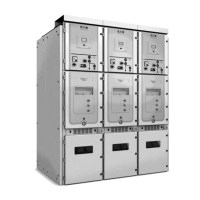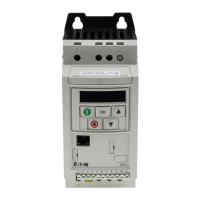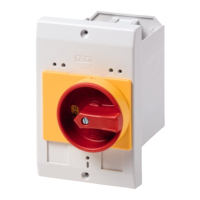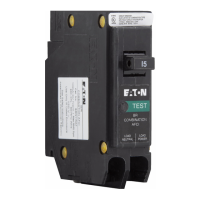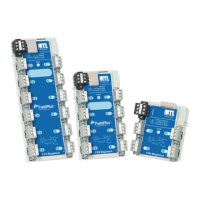36
9 Available protection settings
PXR TRIP UNITS FOR POWER DEFENSE MOLDED CASE CIRCUIT BREAKERS MN012007EN June 2018 www.eaton.com
10 Modbus communication port register map
A ModbusRTU communication module is integrated to the trip unit for certain styles.
10.1 Viewing/setting Modbus parameters
Modbus connection parameters can be viewed and set from LCD display, via PXPM and
Modbus communication. To view from Modbus communication, the settings are stored
beginning at register number 404000 and extending through 404003 and may be read by
using function code 03 or 04, listed in the following table. These four registers can be
written one by one with function code 06 to change Modbus setting. If the data written into
these registers is out of range, it will result in an exception code 03.
Definition Modbus register number Data range
Slave ID 404000 001 – 246 (factory default = 2)
Baud rate 404001 00 = 9600 bit/s
01 = 19200 bit/s (factory default) 02 = 38400 bit/s
03 = 57600 bit/s
Parity 404002 00 = None
01 = Odd
02 = Even (factory default)
Stop bit 404003 00 = 1 bit (factory default)
01 = 2 bits
10.2 Communication protocol
Only the Modbus RTU communication mode is recognized by the trip unit. The trip unit can
support a maximum of 122 registers (244 data bytes) in a single Modbus transaction. The
trip unit responds to Modbus function codes 02, 03, 04, 06, 08 and 16.
10.3 Modbus register map
10.3.1 Input status (discrete inputs)
Input status bits 101001 through 101032 may be available using function code 02. The status
definitions are defined the following table. The first 16 bits are the actual status state while
the late 16 bits indicate whether the corresponding status state is valid, or supported by the
trip unit.
Input Definition Input Definition
1001 Breaker is in the closed position 1017 Breaker is in the closed position is valid
1002 Un-acknowledged trip condition 1018 Un-acknowledged trip condition is valid
1003 Active or un-acknowledged alarm 1019 Active or un-acknowledged alarm is valid
1005 Maintenance mode is active 1021 Maintenance mode is active is valid
1006 Test mode is active 1022 Test mode is active is valid
1010 Long delay pickup is active 1026 Long delay pickup is active is valid
1011 Zone interlock is active 1027 Zone interlock is active is valid
1013 “Ground” is source ground 1029 “Ground” is source ground is valid
10.3.2 Real-time data object registers
The data changing in real time, such as current, voltage, power, etc. are shown in the table
below. Real time data can be obtained either in IEEE floating point or in fixed point format.
For data shown in fixed point format, each result would be the real time data multiplied by
a scale factor. The scale factors are shown as the last column in the table. Energy objects
can be only obtained in fixed point format.
Each data object occupies two registers (four bytes) in length except for certain energy
objects. These energy objects occupy four registers. Since these objects have the capability
to change in real time, a complete data object must be obtained in a single transaction to
avoid data tearing. Attempting to access a partial data object will result in an exception code
84. Refer to a later section entitled “Exception codes”.
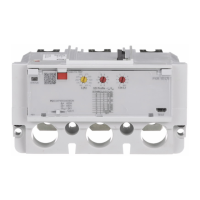
